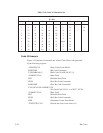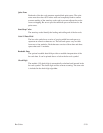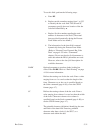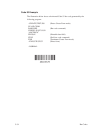5–31Bar Codes
To use this field, perform the following steps:
a. Enter BF.
b. Replace n with a number ranging from 1 to 255
to identify the bar code field. The SR and SC
parameters specify the exact location of the bar
code field identified by n.
c. Replace L with a number equaling the total
number of characters in the field. (The actual
data provided dynamically during the Execute
Form Mode can be less than L.)
d. The information for the data field is entered
dynamically during the Execute Form Mode.
(Refer to “Execute Form: Dynamic Bar Code
Data” on page 4–55 in the “Commands”
chapter.) Do not use the data field parameter to
enter data when the BFn;L parameters are used.
However, refer to the data field description for
available characters.
DARK Optional parameter to produce darker looking bar
codes. Enter DARK. Refer to “Dark Printing” on page
4–10 for more information.
SR Defines the starting row for the bar code. Enter a value
ranging from row 1 to one less than the length of the
form. Character row or dot row is specified based on
the Scale command (page 4–88), or use the CP.DP
format (page 4–7).
SC Defines the starting column of the bar code. Enter a
value ranging from column 1 to one less than the width
of the form. Character column or dot column is
specified based on the Scale command (page 4–88), or
use the CP.DP format (page 4–7).
D The printable character (delimiter) identifying the start
and finish of the data field. Enter any printable
character other than a slash (/), the SFCC, or a
character used within the data.


















